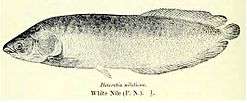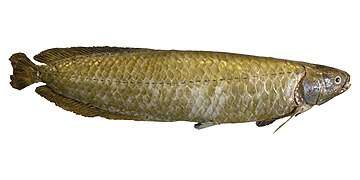African arowana
The African arowana or Nile arowana (Heterotis niloticus) is a species of bonytongue. Despite being called an "arowana", the African arowana is more closely related to arapaimas, the only other members in the family Arapaimidae,[2] than the South American, Asian, and Australian arowanas in the family Osteoglossidae (the Arapaimidae are sometimes included in the Osteoglossidae). Compared to these, the African arowana has a more terminal mouth and is the only one that feeds extensively on plankton.[3]
| African arowana | |
|---|---|
 | |
| Scientific classification | |
| Kingdom: | |
| Phylum: | |
| Class: | |
| Order: | |
| Family: | |
| Genus: | Heterotis Rüppell, 1828 |
| Species: | H. niloticus |
| Binomial name | |
| Heterotis niloticus (G. Cuvier, 1829) | |
| Synonyms | |
|
Genus
Species
| |

Description
The African arowana is a long-bodied fish with large scales, long dorsal and anal fins set far back on the body, and a rounded caudal fin. Its height is 3.5 to 5.0 times standard length. It has been reported to reach up to 1 m (3.3 ft) long and weigh up to 10.2 kg (22 lb).[3]
This fish is gray, brown, or bronze in color. Coloration is uniform in adults, but juveniles often have dark longitudinal bands.
African arowanas have air-breathing organs on its branchiae, enabling them to survive in oxygen-depleted water. A suprabranchial organ allows it to concentrate small planktonic food particles and also has a sensory function.
Range
This species is widespread throughout Africa, where it is native to all the watersheds in Sahelo-Sudanese region, Senegal, and Gambia, as well as parts of eastern Africa. This range includes the basins of the Corubal, Volta, Ouémé, Niger, Bénoué, and Nile Rivers, as well as those of Lake Chad and Lake Turkana. It has been successfully introduced to Côte d'Ivoire, the Cross River in Nigeria, the Sanaga and Nyong Rivers in Cameroon, and the Ogooué River in Gabon, as well as the lower and middle Congo River basin, including Ubangui and Kasaï Rivers. It has also been introduced in Madagascar. In some cases, introduction is reported to have had a negative impact on the local ecology.[3]
Human use
African arowana is used locally as a food and has been collected in the past for the aquarium trade, but behavior of it in captivity. It is not feral or aggressive like its relatives.[4]
References
- Akinyi, E., Azeroual, A., Entsua-Mensah, M., Getahun, A., Lalèyè, P. & Moelants, T. 2010. Heterotis niloticus. In: IUCN 2013. IUCN Red List of Threatened Species. Version 2013.1. <www.iucnredlist.org>. Downloaded on 04 October 2013.
- Froese, Rainer, and Daniel Pauly, eds. (2014). "Arapaimidae" in FishBase. July 2014 version.
- Froese, Rainer and Pauly, Daniel, eds. (2014). "Heterotis niloticus" in FishBase. July 2014 version.
- Nanconnection (2003). (แอบ)คุยเรื่องปลาตู้ โครงการ 2 : ปลาอโรตัวเป็นวาน่าเลี้ยง [(Secretly) talk about the aquarium fish. Project 2: Aro fish is a Wana] (in Thai). Bangkok: SE-ED Book Center. ISBN 9789745348653.
External links
- "Heterotis niloticus". Integrated Taxonomic Information System. Retrieved 24 January 2006.
